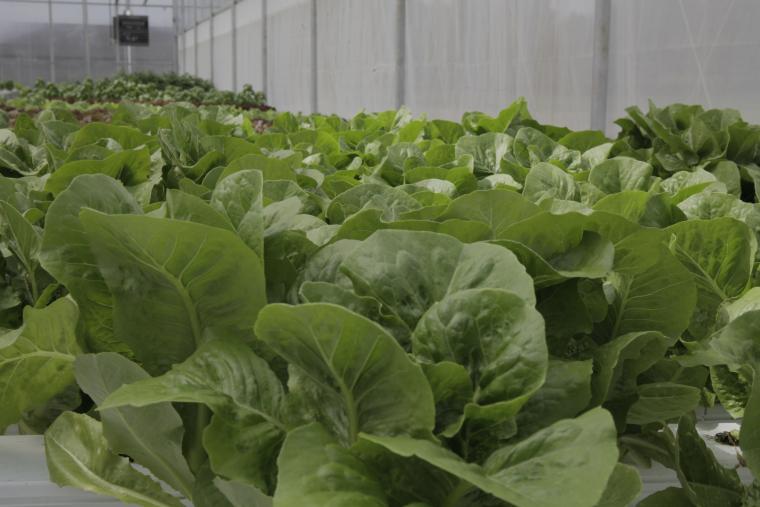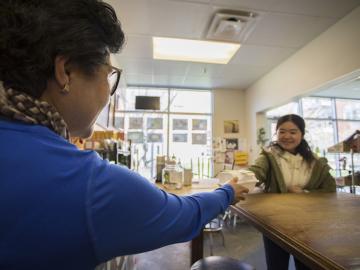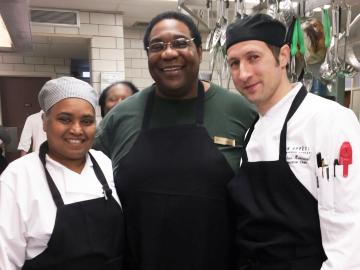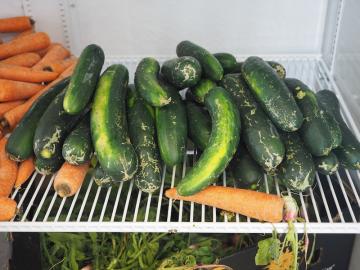It Doesn't Get Any Greener Than This
August 20, 2015
Amanda Nagy

Tyler's Farm Local Food Spotlight
In the food service industry, the standard for what can accurately be called local food pertains to products and ingredients sourced within a 150-mile radius. Bon Appetit Management Company, Oberlin’s food service provider, requires its chefs to purchase at least 20 percent of their food that way. At Oberlin, the amount of locally sourced food is closer to 35 percent throughout the academic year.
Just 1 mile from Tappan Square, a local greenhouse is growing hydroponic lettuce and greens. When the lettuce reaches campus kitchens, it’s barely an hour old. It doesn’t get any greener than this.
When Tyler Gogolek planned to build his hydroponic greenhouse in early 2014, he needed a commitment from potential buyers to secure financing. Although Bon Appetit was already buying salad greens from another local provider, Gogolek piqued the company’s interest. Could he grow spinach and other varieties, he was asked. Construction of the greenhouse finished in December 2014, and the first crop was available the following February. Bon Appetit liked what it saw, and Gogolek started delivering greens to the dining halls in spring 2015.
Hydroponics is growing plants without soil. “It has been used since the ancient times of Babylon. The science is not newly discovered, it’s just newly refined,” says Gogolek, who has been growing garden mums and operating under the name Tyler’s Farm for 20 years. The obvious benefit of a hydroponic growing system is the ability to harvest year-round; it’s also a controlled ecosystem.
“I believe we’re in a series of climate patterns that no one can predict anymore,” Gogolek says. “Here, we can grow in a controlled environment. We can apply light and water and feed at the control of our fingertips, and make the plants happy and consistent in the production cycles. All the nutrients are in the water. The plants don’t have to search for anything.”
Gogolek implements biological insect control—bugs that eat other bugs—which means he doesn’t have to spray pesticide. “The fact that we don’t spray is such a key component. If people knew the things that are applied to their food, I think they would be appalled,” he says.
At any given time, the greenhouse is growing 20 varieties of greens, including various leaf and bibb lettuces, spinach, kale, and stirfry mix. When classes are in session, Gogolek fulfills orders at Oberlin three times per week. He says Bon Appetit has been instrumental in the learning stages of his operation. “We had to find answers to questions like how much product fit in a case, and are we using every bit of what we grow? From the chef’s standpoint, they’ve steered me away and steered me toward. It’s been a great relationship.”
On being local, as in 1-mile-radius-local, Gogolek says the benefits are just amplified. Students can take comfort in knowing their lettuce is simply clean and straight from the farmer. And above all, “it’s nutritious and has great flavor.”
Tags:
You may also like…
Campus Dining Partners with Local Restaurants to Provide Weekly Meal Option
April 13, 2020
For the small population of students remaining on campus this spring, the offering is a welcome reprieve.
Cooking for a Community
April 10, 2017
Chef and community activist Vimala Rajendron trained CDS staff in traditional Indian cuisine over spring break.
Food Hub Keeps Local Food in the Community
July 26, 2016
A venture of the Oberlin Project, the Oberlin Food Hub links local farms with wholesale buyers in Northeast Ohio.


